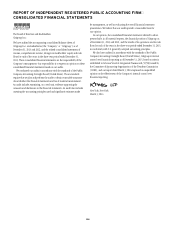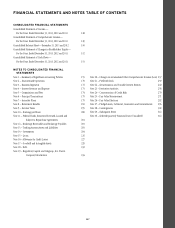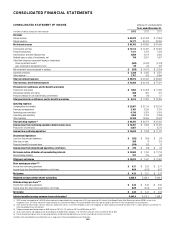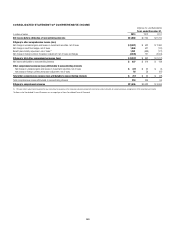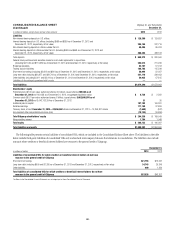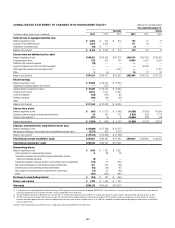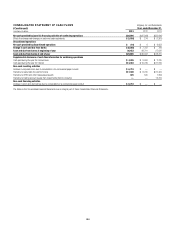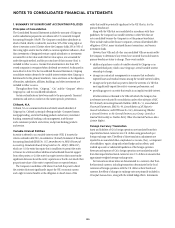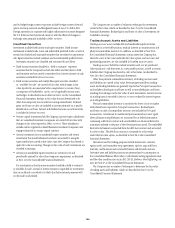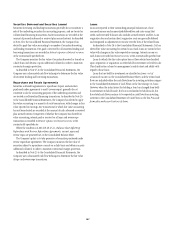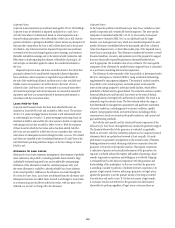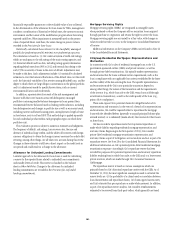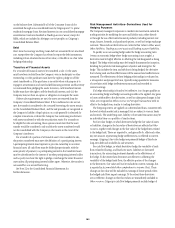Citibank 2013 Annual Report Download - page 173
Download and view the complete annual report
Please find page 173 of the 2013 Citibank annual report below. You can navigate through the pages in the report by either clicking on the pages listed below, or by using the keyword search tool below to find specific information within the annual report.155
NOTES TO CONSOLIDATED FINANCIAL STATEMENTS
1. SUMMARY OF SIGNIFICANT ACCOUNTING POLICIES
Principles of Consolidation
The Consolidated Financial Statements include the accounts of Citigroup
and its subsidiaries prepared in accordance with U.S. Generally Accepted
Accounting Principles (GAAP). The Company consolidates subsidiaries in
which it holds, directly or indirectly, more than 50% of the voting rights or
where it exercises control. Entities where the Company holds 20% to 50% of
the voting rights and/or has the ability to exercise significant influence, other
than investments of designated venture capital subsidiaries or investments
accounted for at fair value under the fair value option, are accounted for
under the equity method, and the pro rata share of their income (loss) is
included in Other revenue. Income from investments in less than 20%
owned companies is recognized when dividends are received. As discussed in
more detail in Note 22 to the Consolidated Financial Statements, Citigroup
consolidates entities deemed to be variable interest entities when Citigroup is
determined to be the primary beneficiary. Gains and losses on the disposition
of branches, subsidiaries, affiliates, buildings, and other investments are
included in Other revenue.
Throughout these Notes, “Citigroup,” “Citi” and the “Company” refer to
Citigroup Inc. and its consolidated subsidiaries.
Certain reclassifications have been made to the prior periods’ financial
statements and notes to conform to the current period’s presentation.
Citibank, N.A.
Citibank, N.A. is a commercial bank and wholly owned subsidiary of
Citigroup Inc. Citibank’s principal offerings include: Consumer finance,
mortgage lending, and retail banking products and services; investment
banking, commercial banking, cash management, trade finance
and e-commerce products and services; and private banking products
and services.
Variable Interest Entities
An entity is referred to as a variable interest entity (VIE) if it meets the
criteria outlined in ASC 810, Consolidation (formerly Statement of Financial
Accounting Standards(SFAS) No. 167, Amendments to FASB (Financial
Accounting Standards Board) Interpretation No. 46(R)) (SFAS 167),
which are: (i) the entity has equity that is insufficient to permit the entity
to finance its activities without additional subordinated financial support
from other parties; or (ii) the entity has equity investors that cannot make
significant decisions about the entity’s operations or that do not absorb their
proportionate share of the entity’s expected losses or expected returns.
The Company consolidates a VIE when it has both the power to direct
the activities that most significantly impact the VIE’s economic success
and a right to receive benefits or the obligation to absorb losses of the
entity that could be potentially significant to the VIE (that is, it is the
primary beneficiary).
Along with the VIEs that are consolidated in accordance with these
guidelines, the Company has variable interests in other VIEs that are
not consolidated because the Company is not the primary beneficiary.
These include multi-seller finance companies, certain collateralized debt
obligations (CDOs), many structured finance transactions, and various
investment funds.
However, these VIEs and all other unconsolidated VIEs are monitored by
the Company to determine if any events have occurred that could cause its
primary beneficiary status to change. These events include:
• additional purchases or sales of variable interests by Citigroup or an
unrelated third party, which cause Citigroup’s overall variable interest
ownership to change;
• changes in contractual arrangements in a manner that reallocates
expected losses and residual returns among the variable interest holders;
• changes in the party that has power to direct the activities of a VIE that
most significantly impact the entity’s economic performance; and
• providing support to an entity that results in an implicit variable interest.
All other entities not deemed to be VIEs with which the Company has
involvement are evaluated for consolidation under other subtopics of ASC
810 (formerly Accounting Research Bulletin (ARB) No. 51, Consolidated
Financial Statements, SFAS No. 94, Consolidation of All Majority-
Owned Subsidiaries, and EITF Issue No. 04-5, Determining Whether
a General Partner, or the General Partners as a Group, Controls a
Limited Partnership or Similar Entity When the Limited Partners Have
Certain Rights).
Foreign Currency Translation
Assets and liabilities of Citi’s foreign operations are translated from their
respective functional currencies into U.S. dollars using period-end spot
foreign-exchange rates. The effects of those translation adjustments are
reported in Accumulated other comprehensive income (loss), a component
of stockholders’ equity, along with related hedge and tax effects, until
realized upon sale or substantial liquidation of the foreign operation.
Revenues and expenses of Citi’s foreign operations are translated monthly
from their respective functional currencies into U.S. dollars at amounts that
approximate weighted average exchange rates.
For transactions whose terms are denominated in a currency other than
the functional currency, including transactions denominated in the local
currencies of foreign operations with the U.S. dollar as their functional
currency, the effects of changes in exchange rates are primarily included in
Principal transactions, along with the related hedge effects. Instruments



